Mystery of the Abbey
Authors: Bruno Faidutti & Serge Laget
Publisherr: Days of Wonder
Year: 2004
review by

| x |
|
|
|
|
|
|
|
|
|
|
|
|
|
|
|
|
|
|
|
|
|
|
|
|
|
|
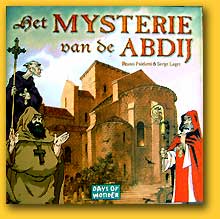 |
Chaos and panic in the Templars’ Abbey: brother Adelmo has been murdered! This unfortunate event happens at the very moment that the players, 3 to 6 pilgrims on their way to Santiago de Compostela, decided to spend the night in this abbey. The Abbot has asked them to investigate and find the killer of brother Adelmo. All the 24 monks that are residing at the abbey are suspects, but who did it? In other words: time for Crime Scene Investigation in a Medieval setting. However, the pilgrims are not working as a team, but they each conduct their own investigations and try to hide their discoveries from their fellow-Sherlocks. |
| x |
|
|
|
|
|
|
|
|
|
|
|
|
|
|
|
|
|
|
|
|
|
|
|
|
|
|
The board map represents a map of the Templars’ Abbey. The players move through the abbey, like in Clue, to look for clues on who of the 24 monks did not commit the murder. Via elimination, one single name will remain of the monk who did kill brother Adelmo.
From the 24 suspect cards, one is randomly drawn and placed face down under the game board: this is the culprit. From the 23 remaining cards, each player receives 3 to 6, depending on the number of players. |
|
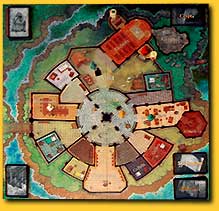 |
| x |
|
|
|
|
|
|
|
|
|
|
|
|
|
|
|
|
|
|
|
|
|
|
|
|
|
|
   |
The remaining cards are placed as a blind stack next to the board. The players receive a suspect sheet where they can mark the suspect cards they have seen in the game (these monks are innocent). |
| x |
|
|
|
|
|
|
|
|
|
|
|
|
|
|
|
|
|
|
|
|
|
|
|
|
|
|
|
The game is played in eight Masses. We start with the Matins and end with the Compline. Each Mass consists of four rounds, that are played as follows. The active player moves his figure 1 or 2 spaces. If he ends his movement in a room with another player, he can ask this player a question. All questions are allowed, as long as the answer does not contain the name of a monk.
The suspect monks have various characteristics: there is three orders (Templar, Franciscan, Benedictine), three titles (Father, brother, novice), hooded or unhooded, bearded or clean-shaven, fat or thin. Possible questions would be ‘How many bearded monks do you have?’; ‘Do you have hooded Fransiscans?’; or the somewhat suggestive ‘Do you have a fat Templar?’.
The questioned player can make a vow of silence and not answer the question, but then he is not allowed to ask a question in return. However, if he answers the question he can subsequently ask a question in return. After the questioning, the special action of the room you are in is resolved:
|
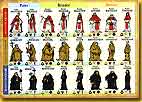
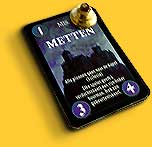 |
| x |
|
|
|
|
|
|
|
|
|
|
|
|
|
|
|
|
|
|
|
|
|
|
|
|
|
|

 |
|
Library: full of interesting books; draw a library card that supplies you with valuable information (look at all the cards of a player, or look at one card of each player et cetera) Because these cards are very strong, a player is allowed to visit the library only once in a game.
Parlour: a lot of chatting is going on in here; take a suspect card from the pile which enables you to eliminate a monk as a suspect.
Cells: draw a suspect card from the owner of the cell. If the owner in his turn returns to his cell with you still in it nosing around his stuff, you must return the card but hey, that piece of information has already been noted on your suspects sheet!
|
|
 |
|
| x |
|
|
|
|
|
|
|
|
|
|
|
|
|
|
|
|
|
|
|
|
|
|
|
|
|
|
|
Crypt: take a crypt card. This can be used later in the game for an extra turn.
Scriptorium: scriptorium cards can be obtained here that allow you to, for example, move one extra space or look at the cards of another player.
|
|
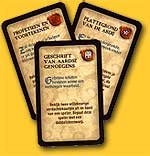 |
| x |
|
|
|
|
|
|
|
|
|
|
|
|
|
|
|
|
|
|
|
| x |
|
|
|
|
|
|
|
|
|
|
|
|
|
|
|
|
|
|
|
 |
|
|
|
|
|
|
|
|
|
|
|
|
|
|
|
 |
|
|
|
|
|
|
|
|
|
|
|
|
|
|
|
 |
|
|
|
|
|
|
|
|
|
|
|
|
|
|
|
| x |
|
|
|
|
|
|
|
|
|
|
|
|
|
|
|
|
|
|
|
|
|
|
|
|
|
|
 |
|
|
|
|
|
|
|
|
|
|
|
|
|
|
|
|
 |
|
|
|
|
|
|
|
|
|
|
|
|
|
|
|
|
|
|